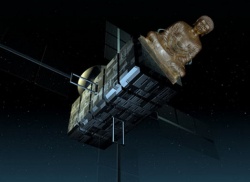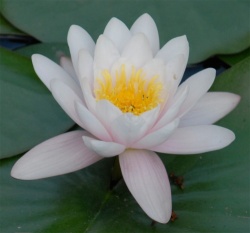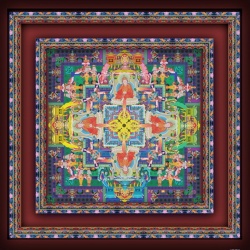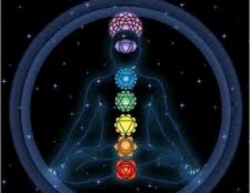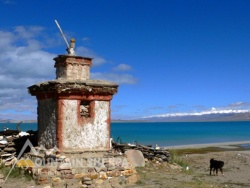Karma Kagyu
Karma Kagyu (Tibetan: ཀརྨ་བཀའ་བརྒྱུད, Wylie: karma bka'-brgyud), or Kamtsang Kagyu, is probably the largest and certainly the most widely practiced lineage within the Kagyu school, one of the four major schools of Tibetan Buddhism. The lineage has long-standing monasteries in Tibet, China, Russia, Mongolia, India, Nepal, and Bhutan, and current centers in at least 62 countries. The spiritual head of the Karma Kagyu is the Gyalwa Karmapa, and the 2nd through the 10th Karmapas were the principal spiritual advisors to successive Emperors of China. The Karma Kagyu are sometimes called the "Black Hat" Lamas, in reference to the Black Crown worn by the Karmapa.
Origins
The Karma Kagyu was founded by the first Karmapa, Jetsun Dusum Khyenpa. It is headed by the Gyalwa Karmapa, a reincarnate lama (tulku). Followers believe that the Karmapa's appearance as the first historical consciously reincarnate teacher was predicted by the Buddha in the Samadhiraja Sutra (lit: Discourse on the Kings of Meditative Concentration).
Teachings
The Karma Kagyu school belongs to the Vajrayana branch of Mahayana Buddhism. It is a Triyana (all three turnings of the Wheel of the dharma) school (e.g., monks and nuns keep the vows of Vinaya while lay practitioners hold the Upasaka vows) and a Rime (non-sectarian) tradition.
The central teaching of the Karma Kagyu is the doctrine of Mahamudra, also known as the "Great Seal". This doctrine focuses on four principal stages of meditative practice (the Four Yogas of Mahamudra):
- The development of single-pointedness of mind,
- The transcendence of all conceptual elaboration,
- The cultivation of the perspective that all phenomena are of a "single taste",
- The fruition of the path, which is beyond any contrived acts of meditation.
It is through these four stages of development that the practitioner is said to attain the perfect realization of Mahamudra. Mahamudra is practiced both independently and as the completion stage of Vajrayana practice.
Within the Karma Kagyu, meditative practice is almost invariably presented in a progressive manner. Early practice includes Shamatha meditation (calm abiding; single-pointedness), introduction to Buddhist history and philosophy, and initiation into the lower Tantras - classically across the Yidams (deities) Avalokiteshvara (Tibetan Chenrezik), Tara and Amitabha Buddha. This is followed by Ngondro (thepractice of the Four Extraordinary Foundations) and Vipassana meditation. During the traditional three-year retreat, retreatants usually focus their practice on the Six Yogas of Naropa. At the Anuttarayogatantra level of practice, the principal Yidams of the lineage are Vajravarahi, Hevajra and Chakrasamvara.
While one of the distinguishing characteristics of the Karma Kagyu is its emphasis on meditative practice, all forms and levels of Buddhist history and philosophy are also taught, most notably the Shentong branch of Prāsaṅgika Madhyamaka philosophy.
Lamas
The supreme Lama of the Karma Kagyu is the Karmapa, who always presides as lineage holder once he has reached his majority and received all the necessary training and transmissions. From the death of one Karmapa until the next takes his seat as lineage holder, one (or more) of the previous Karmapa's principal disciples holds the lineage. The 16th Gyalwa Karmapa Rangjung Rigpe Dorje left the lineage in the hands of four eminent Lamas; the 14th Shamar Rinpoche, the 12th Tai Situ Rinpoche, the 3rd Jamgön Kongtrül Rinpoche and the 12th Goshir Gyaltsab Rinpoche. There is some controversy over who is the 17th Karmapa, with two major candidates both having been recognized and enthroned by their supporters. Neither candidate has been enthroned at Rumtek Monastery.
The direct master-disciple transmission of the lineage holders of the Karma Kagyu is known as the Golden Rosary of Kagyu Fathers. They are: showing lineage holders.
- Vajradhara (Tib. Dorje Chang)
- Tilopa 989-1069 C.E.
- Naropa 1016-1100 C.E.
- Marpa 1012-1097 C.E.
- Milarepa 1040-1123 C.E.
- Gampopa 1079-1153 C.E.
- 1st Karmapa Düsum Khyenpa 1110-1193 C.E.
- Drogon Rechen 1148-1219 C.E.
- Pomdrakpa 1170-1249 C.E.
- 2nd Karmapa Karma Pakshi 1204-1283 C.E.
- Orgyenpa 1230-1312 C.E.
- 3rd Karmapa Rangjung Dorje 1284-1339 C.E.
- Yungtonpa 1296-1376 C.E.
- 4th Karmapa Rolpe Dorje 1340-1383
- 2nd Shamarpa Khacho Wangpo 1350-1405 C.E.
- 5th Karmapa Deshin Shekpa 1384-1415 C.E.
- Ratnabhadra (dates unknown)
- 6th Karmapa Thongwa Dönden 1416-1453 C.E.
- Jampal Zangpo 1427-1489 C.E.
- 1st Gyaltsab Rinpoche Paljor Dondrup 1427-1489 C.E.
- 7th Karmapa Chödrak Gyatso 1454-1506 C.E.
- 1st Sangye Nyenpa Rinpoche Tashi Paljor 1457-1525 C.E.
- 8th Karmapa Mikyö Dorje 1507-1554 C.E.
- 5th Shamarpa Kongchok Yanglak 1526-1583 C.E.
- 9th Karmapa Wangchuk Dorje 1555-1603 C.E.
- 6th Shamarpa Chokyi Wangchuk 1584-1629 C.E.
- 10th Karmapa Chöying Dorje 1604-1674 C.E.
- 7th Shamarpa Yeshe Nyingpo 1631-1694 C.E.
- 11th Karmapa Yeshe Dorje 1676-1702 C.E.
- 8th Shamarpa Chokyi Dondrup 1695-1732 C.E.
- 12th Karmapa Changchub Dorje 1703-1732 C.E.
- 8th Situpa Chokyi Jungney 1699-1774 C.E.
- 13th Karmapa Dudul Dorje 1733-1797 C.E.
- 10th Shamarpa Mipham Chodrub Gyatso 1742-1793 C.E.
- 9th Situpa Pema Nyinche Wangpo 1774-1853 C.E.
- 14th Karmapa Thekchok Dorje 1798-1868 C.E.
- 1st Jamgon Kongtrul Rinpoche Lodrö Thayé 1813-1899 C.E.
- 15th Karmapa Khakyab Dorje 1871-1922 C.E.
- 11th Situpa Pema Wangchuk Gyalpo 1886-1953 C.E.
- 2nd Jamgon Rinpoche Palden Khyentse Oser 1904-1953 C.E.
- 16th Karmapa Rangjung Rigpe Dorje 1924-1981 C.E.
Because of the Karmapa controversy, the identities of the next lineage holders have not been definitively identified. In all likelihood, they are either:
- 42. 12th Situpa Péma Tönyö Nyinjé 1954–present C.E.
- 43. 17th Karmapa Ogyen Trinley Dorje 1985–present C.E.
or
- 42. 14th Shamarpa Mipham Chokyi Lodro 1952–present C.E.
- 43. 17th Karmapa Trinley Thaye Dorje 1983–present C.E.
At the next level of precedence, all Kagyu Lamas who have been accorded by His Holiness the title Rinpoche (Lit: precious one) are highly regarded as trustworthy teachers. Those who hold the Khenpo degree have completed the equivalent of a doctorate in Buddhist studies.
There are (both currently and historically) many female Kagyu Lamas. For example, in the Refuge Tree pictured above, two of the figures floating in the sky above the tree (Dakini Sukhasiddhi and Machig Labdron) are great historical female Lamas of the lineage. Her Eminence Mindrolling Jetsün Khandro Rinpoche is a living female tulku (reincarnate Lama) of the Karma Kagyu. Probably the most well-known active female Kagyu Lamas in the West are Ani Pema Chödrön and Tsultrim Allione.
